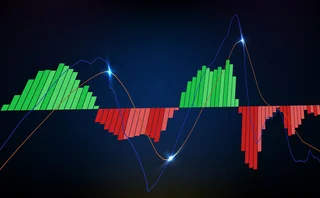
Follow the moneyness
Barclays quants extend Bergomi’s skew stickiness ratio to all strikes
Like their peers at most major banks, equity derivatives traders at Barclays rely on the skew stickiness ratio (SSR) to monitor the correlation between implied volatility and spot prices – a crucial factor when managing options portfolios.
Introduced by Lorenzo Bergomi in 2009, the SSR is defined as the regression coefficient of the at-the-money (ATM) forward volatility with respect to the spot price, normalised by the ATM forward skew. More loosely, it is a measure of the covariance between the spot price and the ATM forward volatility.
But the SSR is not without limitations. Crucially, it describes the joint dynamics of implied volatility and spot prices only at the ATM strike. That can be a problem when dealing with exotics, which are sensitive to many different strikes.
Popular products such as autocallables contain embedded put options with a knock-in barrier, usually at around 60–70% of moneyness. These products are therefore sensitive to both the ATM and out-of-the money downside strikes, which are not independent. If the ATM strike moves, the wing of the volatily smile also moves, so it is desirable to look at them jointly.
Olaf Torné, equity derivatives quantitative analyst at Barclays, together with his colleague Jingyi Huang, set out to tackle this problem. They expanded the SSR to create a new measure called varswap SSR, which allows traders to monitor what happens not only ATM but along all moneyness levels. This is achieved by utilising variance swaps, which reflect volatility across all strikes and can be used to calculate the varswap SSR.
“The skew structure on the volatility surface is quite well summarised by a variance swap strike as a first approximation. So using the variance swap as a kind of a rough description of the dynamics of the entire skew structure makes a lot of sense from an equity trading perspective” says Torné.
In practice, rather than looking only at the covariance between spot and ATM volatility, the authors look at the covariance between spot prices and the variance swap strike.
Using the variance swap as a kind of a rough description of the dynamics of the entire skew structure makes a lot of sense from an equity trading perspective
Olaf Torné, Barclays
Because SSR is a dimensionless value that is expressed as a ratio, it allows for comparisons between different positions and models. It’s also easily interpretable and provides a clear indication of volatility surface dynamics – an SSR of one signifies a sticky strike, while an SSR of zero reveals a sticky delta.
For instance, if the spot price of an equity changes from one day to the next while the implied volatility remains constant, then the delta is said to be sticky. In other words, a sticky delta indicates implied volatilities at fixed moneyness don’t move. But if instead the implied volatility corresponding to a given moneyness changes in concert with the spot price, that would be a sticky strike.
Torné is clear this should not be used as a trading signal. “SSR doesn’t change the way a trader trades, it is just a way of describing what the model does and allows [them] to get a better handle on it,” he says. “But at the same time, I wouldn’t undersell the usage of tools like this one, because they are really the key to understanding your model and if you don’t understand your model you cannot really use it properly.”
In their paper, Torné and Huang show how varswap SSR can be applied in practice using the popular local volatility and Heston models. The Heston model was chosen primarily because it is ubiquitous and a canonical choice for didactical and exemplary purposes, which is in line with the authors’ objective for this work. But the approach can be applied to any volatility model.
“An extension to local stochastic volatility models would be a useful addition to the current paper. That might be a project for the future,” says Torné.
Only users who have a paid subscription or are part of a corporate subscription are able to print or copy content.
To access these options, along with all other subscription benefits, please contact info@risk.net or view our subscription options here: http://subscriptions.risk.net/subscribe
You are currently unable to print this content. Please contact info@risk.net to find out more.
You are currently unable to copy this content. Please contact info@risk.net to find out more.
Copyright Infopro Digital Limited. All rights reserved.
You may share this content using our article tools. Printing this content is for the sole use of the Authorised User (named subscriber), as outlined in our terms and conditions - https://www.infopro-insight.com/terms-conditions/insight-subscriptions/
If you would like to purchase additional rights please email info@risk.net
Copyright Infopro Digital Limited. All rights reserved.
You may share this content using our article tools. Copying this content is for the sole use of the Authorised User (named subscriber), as outlined in our terms and conditions - https://www.infopro-insight.com/terms-conditions/insight-subscriptions/
If you would like to purchase additional rights please email info@risk.net
More on Views
Filling gaps in market data with optimal transport
Julius Baer quant proposes novel way to generate accurate prices for illiquid maturities
Georgios Skoufis on RFRs, convexity adjustments and Sabr
Bloomberg quant discusses his new approach for calculating convexity adjustments for RFR swaps
A dynamic margin model takes shape
New paper shows how creditworthiness and concentrations can be reflected into margin requirements
How HSBC got better at pricing share buy-backs
Monte Carlo approach generates faster, more reliable pricing for complex deals
Degree of influence 2023: Quants thrive on volatility
Climate, crypto and market impact also featured among the top research topics in 2023
How to account for banks’ contribution to CO2 emissions
Price adjustments will depend on individual counterparties’ carbon footprints
Exploiting causal biases in market impact models
Model calibration gains efficiency by including biased but adjusted trading data
Skew this: taking the computational burden off basket options
Dan Pirjol presents a snap formula for estimating implied volatility skew in an instant








